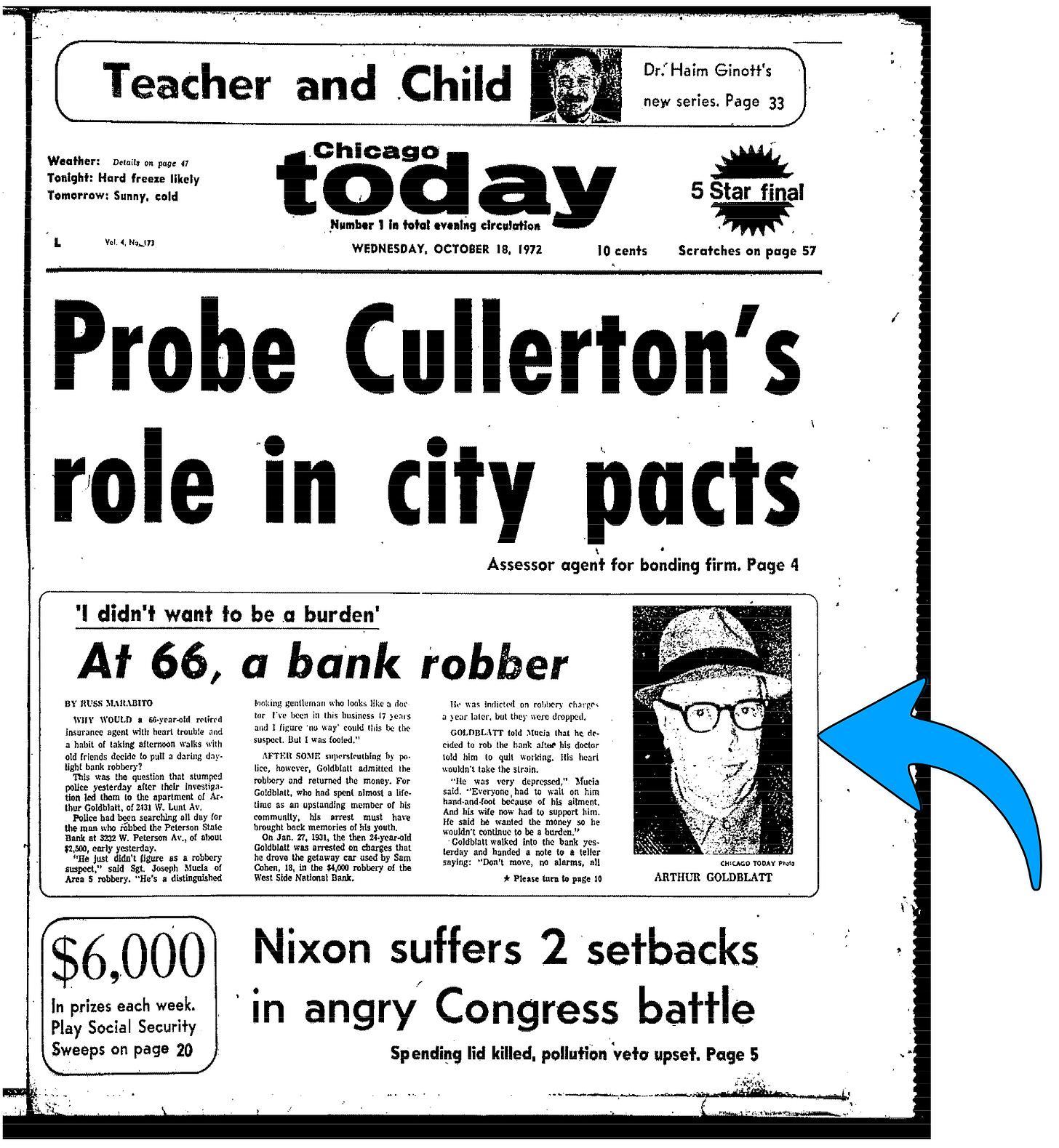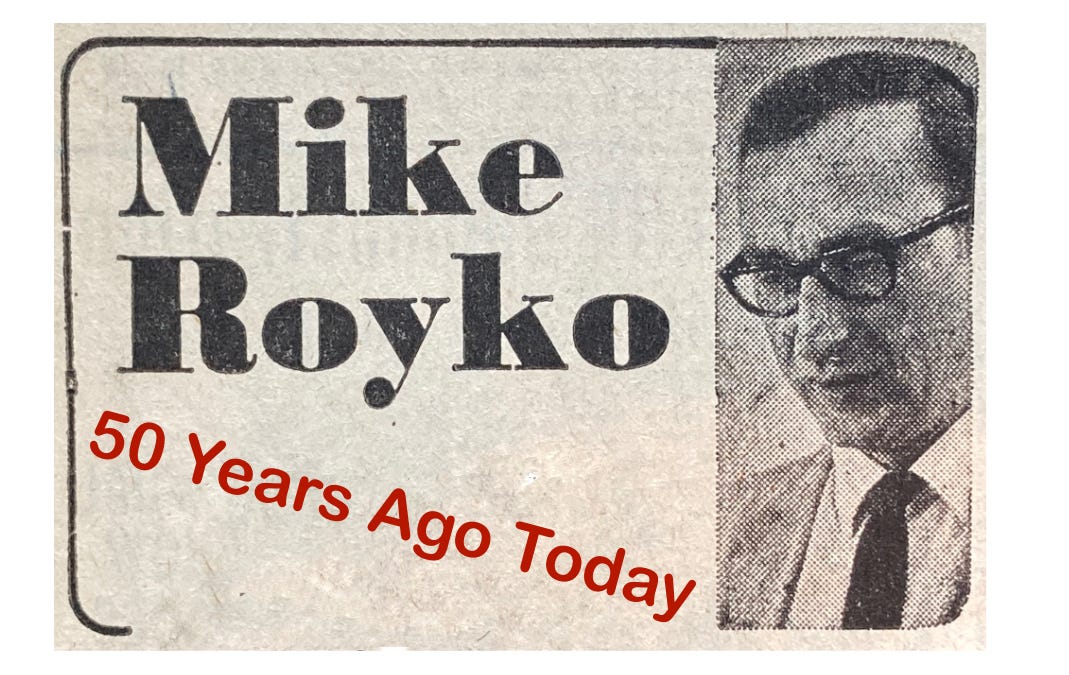THIS CRAZY DAY IN 1972: Life Happens Edition
October 16-22, 1972 Addendum
To access all website contents, click HERE.
Why do we run this separate item peeking into newspapers from 1972? Because 1972 is part of the ancient times when everybody read a paper. Everybody, everybody, everybody. Even kids. So Steve Bertolucci, the 10-year-old hero of the novel serialized at this Substack, read the paper too—sometimes just to have something to do. These are some of the stories he read. Follow THIS CRAZY DAY on Twitter: @RoselandChi1972.
Well, I thought I could keep up the pace through the end of the year, but my immune system had other plans. In truth I’ve been putting two weeks of work into one, and a common cold finally struck me down. Also my back went out from spending too much time sitting at the computer. With the holidays coming up and some traveling in these final two months, time will be even more scarce. So, new plan: We’ll finish a thorough weekly coverage of 1972 at a slower pace—a new full TCD72 one week, Mike Royko for the same time period the following week.
I realize this means you’ll wait a little longer to find out whether President Nixon wins re-election over Sen. George McGovern. Sorry about that. Think about it like suspense in an Alfred Hitchcock movie, because it is the same thing, isn’t it?
Today, we’ll do an Addendum for the week, with the full TCD72 coming next week. This is a taste of what I planned for next year—shorter TCD72’s, since the most major news and events of the day will have been covered.
That said, when we start over with Jan. 1, 1972, you’ll be shocked at some of the big stories and ongoing scandals I was forced to skip on the initial trip through 1972. And so many crazy fun things that got crowded out by police brutality, Mayor Daley getting kicked out of the Democratic National Convention, and the presidential election!
There will also be weeks focused on a single 1972 topic, plus wrap-ups on 1972 people and events. We’ll look at how certain scandals and issues resolved post-’72, and what happened to our high-profile 1972 people.
There is still much work to be done on 1972.
October 18-19, 1972: Arthur Goldblatt
There’s a reason I chose last week to run multiple Goldblatt’s ads, highlighting the mercantile might and ubiquity of Goldblatt’s in 1972.
The Grand Opening of the Goldblatt’s Home Improvement Center in Downer’s Grove, an early version of Home Depot, was just one of multiple two-page spreads which Goldblatt’s took out in many issues of each paper last week. That’s normal advertising volume for Goldblatt’s.
As I noted on August 8, Goldblatt’s buys so much advertising, and engages in so many business activities, I don’t know why they didn’t just start their own paper.
On May 29, I noted that Goldblatt’s even takes out many full-page ads in the Tribune, the paper that gets nearly all the advertising from classy joints like Bonwit Teller and Saks. So Goldblatt’s knows it has many customers among Trib readers too, not just the readers of more middle and working class papers.
There seems to be nothing Goldblatt’s doesn’t sell, from men and women’s fashions to lighting, furniture and pots and pans; nothing Goldblatt’s doesn’t do, from making awnings, reupholstering furniture and repairing shoes to building porches and rehabbing houses. They’re like Home Depot Meets Sears.
Goldblatt’s is everywhere.
So when I read this week’s papers, I couldn’t help but think about how odd it would be to carry the last name “Goldblatt” in Chicago and not have any money.
“Why would a 66-year-old retired insurance agent with heart trouble and a habit of taking afternoon walks with old friends decide to pull a daring daylight bank robbery?”
Chicago Today’s Russ Martino poses that good question for his lead today.
“This was the question that stumped police yesterday after their investigation led them to the apartment of Arthur Goldblatt, of 2431 W. Lunt Av.”
“Police had been searching all day for the man who robbed the Peterson State Bank at 3232 W. Peterson Av. of about $2,500 early yesterday.” That’s $16,875 in 2022 money.

“‘He just didn’t figure as a robbery suspect,’ said Sgt. Joseph Mucia of Area 5 robbery. ‘He’s a distinguished-looking gentleman who looks like a doctor. I’ve been in this business 17 years and I figure ‘no way’ could this be the suspect.’”
But yes! Arthur Goldblatt, who’s had both a stroke and a heart attack, had driven to Peterson State Bank, where he is a customer, parked in the lot, and calmly walked inside. Once he got to the head of the line, he handed the teller a note that said, “Don’t move. No alarms. All your money in packages of 100s, 50s, 20s and 10s,” per the Daily News.
And he showed the teller a gun.
“Gathering the money he slowly walked outside and drove away in his green 1967 Dodge,” wrote the News’ Robert W. Billings, whose name you’ve seen even more often in TCD72 lately because he wrote Dick Butkus’ current best seller, “Stop-Action.”
Chicago Today wrote that Goldblatt “shuffled” out of the bank.
Another teller ran out in the parking lot and saw Arthur Goldblatt drive slowly away. The teller got a description, but either a partial plate number, a number with transposed numerals, or a number with a missing digit, depending on the account.
“Investigators cross-checked every numerical possibility and came up with a green Dodge registered to Goldblatt,” wrote Billings.
Detective Mucia checked it out. Arthur Goldblatt didn’t crack.
“He had me fooled,” Mucia told all the papers. To the Trib’s David Young, he added, “I almost gave him a pass. The FBI had already given up on the guy and left.”
“I went and talked to him,” Mucia told the News. “He didn’t look like a bank robber. He showed no emotional signs. I talked to the neighbors. They almost laughed at me. They said it wasn’t possible.
“I talked to his wife and daughter. They have a very nice apartment. I was assured it couldn’t have been him. But his car fit the teller’s description to a T, right down to the dent in the right rear fender.”
“Usually a suspect tips his hand somewhere, but this guy was calm and unconcerned,” Mucia explained to the Trib. “So we decided to go down to the Federal Building and look at the videotapes of the robbery.”
Mucia left two investigators to keep Goldblatt under surveillance, Art Hamilton and Robert Boris.
“A little later, Goldblatt came out and opened the trunk of his car, pulled out a pistol and began wrapping it in a sheet,” wrote Today.
Hamilton and Boris popped out.
“The pistol, which had looked so real to the bank teller, was a toy.”
“Goldblatt admitted the robbery when confronted with the evidence…On him police found four marked $50 bills.”
“He told me that all his life, he had been an active man, but he had been ill and wanted to contribute to his support,” Mucia told the Trib. “He almost got away with it. He robbed his own bank, but all the videotapes showed was the back side of some guy walking out the door.”
Per Chicago Today, “Goldblatt told Mucia that he decided to rob the bank after his doctor told him to quit working. His heart wouldn’t take the strain. ‘He was very depressed,’ Mucia said. ‘Everyone had to wait on him hand-and-foot because of his ailment. And his wife now had to support him. He said he wanted the money so he wouldn’t continue to be a burden.’”
It turned out that 24-year-old Arthur Goldblatt was indicted in 1931 for driving the getaway car in a $4,000 robbery at West Side National Bank, pulled off by 18-year-old Sam Cohen. But the charges were dropped. According to the inflation calculator, that was almost $80,000 in 2022 money.
“I’m still fooled,” Mucia told the papers. “It’s still hard for me to believe.”
Don’t miss Mike Royko 50 Years Ago Today
October 18, 1972
Chicago Daily News: Circulation ad, 2/3 page
Competition heightens for dwindling newspaper audiences! The Daily News began this promotional campaign over the summer. Until now, they’ve been running tiny ads in this series at the bottom of pages, clearly used as filler. This is the first one taking up most of a page.
Here are a couple examples of the typical spots in this series—again, running small at the bottom of the page:
Look at the Daily News going for modern 1970s young adults. Women! And a guy with a real ‘70s mustache and bad long haircut, plus wire rim glasses. Note however that the woman is interested in fashion and clearly doesn’t know anything about cars, so she has to worry about whether she can trust her auto mechanic. The man is looking forward to an upcoming article in the financial section.
What about the slant of this promotional campaign? The Daily News is highlighting its reputation as the brainy paper with its big network of foreign bureaus and intellectual writers. By calling itself “class,” I think the Daily News also wants to subtly hint that its competitor, Chicago Today, is still the trashy alternative.
Re the heightened overall newspaper competition: Recall that Chicago Today recently announced it will be going to a five-day print product in 1973, which will mean lay-offs—even though Today was touting its dominance over the Daily News in circulation just last week.
Presumably that’s true, but the Daily News has the bulk of afternoon advertising.
October 19, 1972
Chicago Sun-Times: More Arthur Goldblatt
by Art Petaque
Maybe that story yesterday was a little too perfect?
“A 66-year-old insurance agent who had claimed he robbed a Chicago bank Wednesday only because he was ill and ‘didn’t want to be a burden’ later told investigators he had held up three other financial institutions,” writes the Sun-Times’ Art Petacque.
This week, it turns out, was Arthur Goldblatt’s fourth robbery since his 1931 brush with the law, when the 24-year-old Arthur was charged with driving the getaway car for 18-year-old Sam Cohen after he robbed West Side National Bank of almost $80,000 in 2022 money. Those charges were dropped, for some reason.
Goldblatt told the FBI he pulled the three earlier robberies “to help him through slim financial periods in his insurance job.”
The other jobs:
—American National Bank & Trust, 33 N. La Salle, 1970—$3,569 ($24,000 in 2022)
—Rogers Park Savings & Loan, 7002 N. Clark, 1965—$1,100 ($10,000 in 2022)
—State National Bank, 1603 Orrington, Evanaton, 1964—$1,092 ($10,000 in 2022)
Arthur Goldblatt won’t face charges for the 1960s robberies due to the statute of limitations. He’s been released on $20,000 personal recognizance bond for Wednesday’s heist.
But he really does have heart trouble.
Did you dig spending time in 1972? If you came to THIS CRAZY DAY IN 1972 from social media, you may not know it’s part of the novel being serialized here, one chapter per month: “Roseland, Chicago: 1972” —FREE. It’s the story of Steve Bertolucci, 10-year-old Roselander in 1972, and what becomes of him. Check it out here.




















